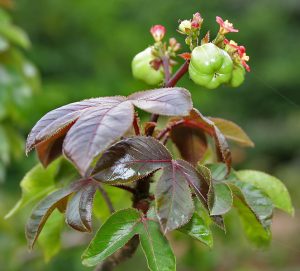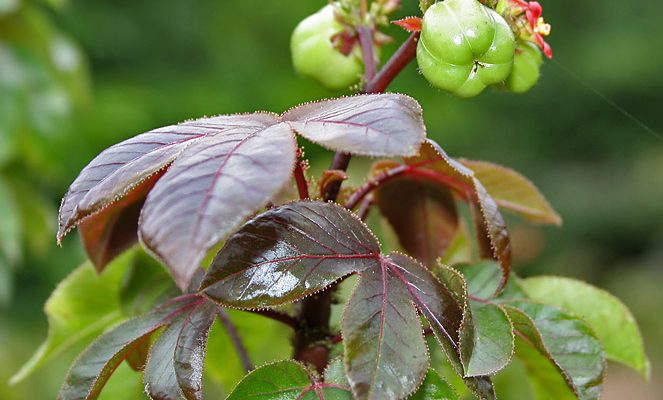Jatropha gossypiifolia
Health Benefits of Jatropha Gossypiifolia

Jatropha gossypiifolia is a shrub that grows in tropical climates and is known by various names such as Bellyache Bush, Cotton Leaf, and Leprous Tree. It has been used in traditional medicine to treat a variety of ailments such as abdominal pain, arthritis, asthma, constipation, eczema, fever, hernia, itching, leprosy, liver diseases, malnutrition, menstrual disorders, piles, sexually transmitted diseases, skin diseases, stomach ache, teething problems, and toothache.
Jatropha gossypiifolia has been found to have antibacterial, anticancer, anti-inflammatory, antileukemic, and blood-purifying properties. It also contains apigenin, B-sitosterol, fatty oil, flavonoids, isovitexin, resins, saponins, tannins, triterpenes, and vitexin
How to use Jatropha gossypiifolia
The leaves are blood purifiers, febrifuge, purgative and stomachic. A decoction of Jatropha gossypiifolia
is taken to cleanse the blood and to treat venereal disease, heart problems, diarrhoea, stomach ache and indigestion
The leaf sap is applied to the tongues of babies to treat thrush. A poultice of the leaves is used for treating sores, bruising, swellings, inflammations, headaches and piles.
An infusion of the leaves is mixed with soft grease for applying to cuts.
The sap has a widespread reputation for healing wounds, as a haemostatic and for curing skin problems; it is applied externally to treat infected wounds, ulcers, cuts, abrasions, ringworm, eczema, dermatomycosis, scabies and venereal diseases.
It is also used against pains, including bee and wasp stings
Jatropha gossypiifolia and seed are boiled in liquid as a remedy for stomach ache[
The seeds are used as a purgative and to expel internal parasites
In Madura, Indonesia, 20 seeds taken after roasting is considered to be a single dose for an adult.
Curcin and an emetic are present
An oil obtained from the seeds is a powerful purgative and emetic, with an action similar to that of Jatropha curcas. It is taken to expel internal parasites.
The oil has been used externally as a rubefacient to treat rheumatic conditions and a variety of skin conditions, including leprosy, although its use on the skin may also cause an irritative rash
The yellowish-brown pith of old stems is sold in Ghana markets as a medicine to cure a headache. It is wrapped in a clean cloth and inserted into the nostrils of the patient to cause sneezing.
A bark decoction is used as an emmenagogue.
The dried and pulverized root bark is made into poultices and is taken internally to expel worms and to treat oedema.
The whole plant has been popularly used in Costa Rica for treating cancers.
A news article that describes how to use Jatropha gossypiifolia to cure HIV/AIDS. However, please note that this claim has not been scientifically validated.
Some properties of Jatropha gossypiifolia
The plant contains jatropholone terpenes, which have antitumor properties. Gossypibetiline, tetrahydrogossypibetiline, gadain and the irritant diterpenoid 12-deoxy-16-hydroxy-phorbol have been isolated.
The leaf contains tannins and histamines.
An alcoholic root extract showed significant inhibitory activity in different human cancer cell lines. This finding led to the isolation of the macrocyclic diterpenes jatrophone and related jatrophanes. In addition, it was found that jatrophone had direct inhibitory effects on contractions of cardiac and smooth muscle preparations, which were typically non-competitive in nature.
An ethanol extract from the stems caused a significant and dose-dependent reduction of systolic blood pressure.
A leaf extract showed significant activity as an anticoagulant for haematological analyses. The anticoagulant effect of the extract was found to be comparable to that of dipotassium ethylenediamine tetraacetic acid. The leaf extract must be purified to remove interfering substances to make it suitable for biochemical analyses. On the contrary, the sap from the stem showed significant coagulant activity in vitro.
Crude hot water extracts from the aerial parts were examined for antimalarial properties against Plasmodium falciparum in vitro and were found to be capable of 100% growth inhibition.
Hexane extracts of the fresh fruits showed significant activity against fungi and some bacteria.
Stem sap was found to inhibit the growth of Helminthosporium oryzae and Alternaria brassicicola. The ethanolic stem extract showed significant larvicidal activity against larvae of the tick Boophilus microplus.
In addition to the compounds mentioned above, phytochemical investigations revealed the presence of lignans (e.g. Gadain, jatrodien, gossypifan, gossypidien and prasanthaline) in the light petroleum extract of stem, root and seeds, the alkaloid jatrophine in the sap, and flavonoids (apigenin, vitexin and isovitexin) and triterpenes in the ethanolic leaf extract.
Side Effect
According to the sources I found, excessive consumption of Jatropha gossypiifolia may cause vomiting, diarrhoea, or stomach ache
Please note that the information provided is for educational purposes only and should not be considered as medical advice. If you are considering using Jatropha gossypiifolia for medicinal purposes, please consult a healthcare professional first

